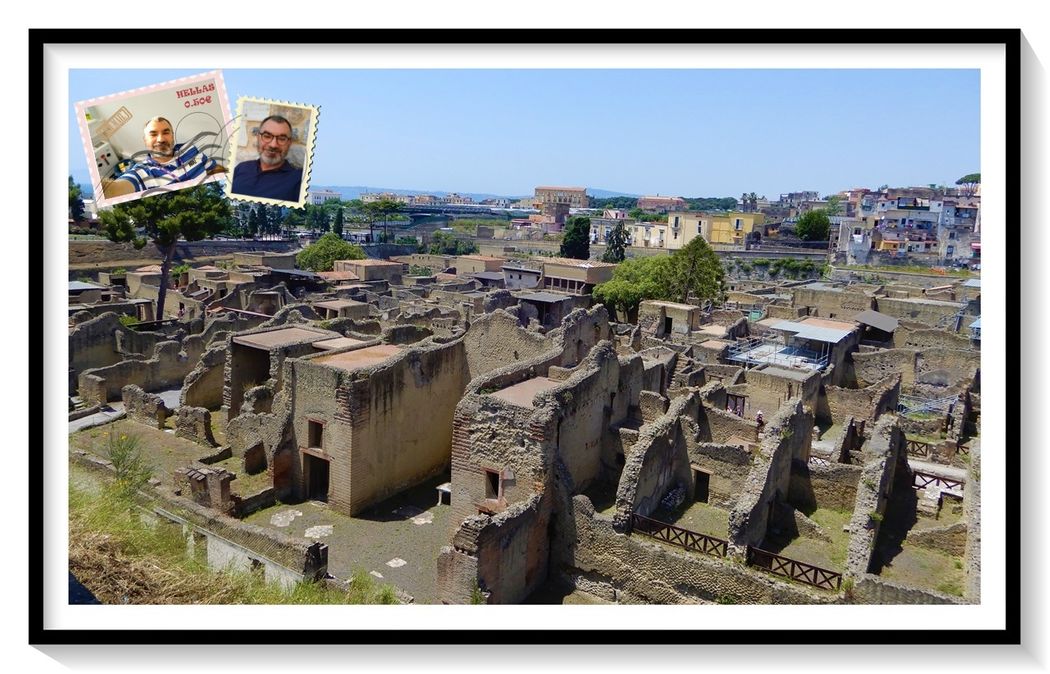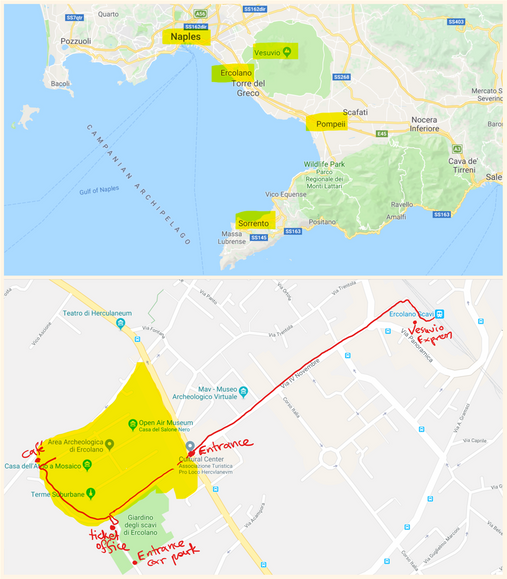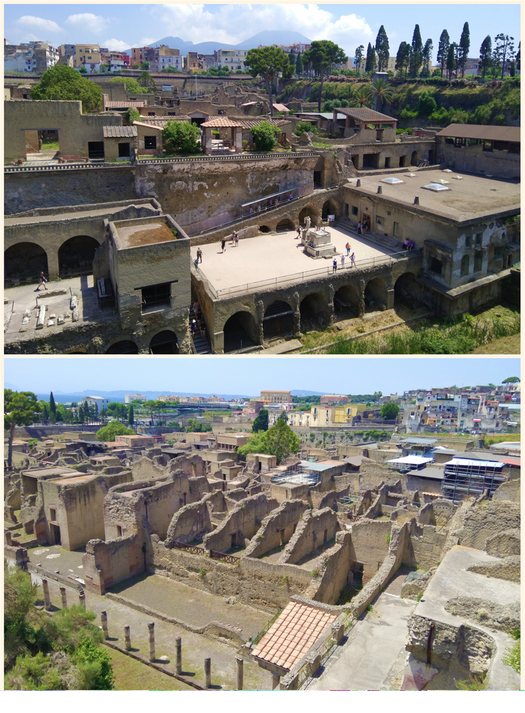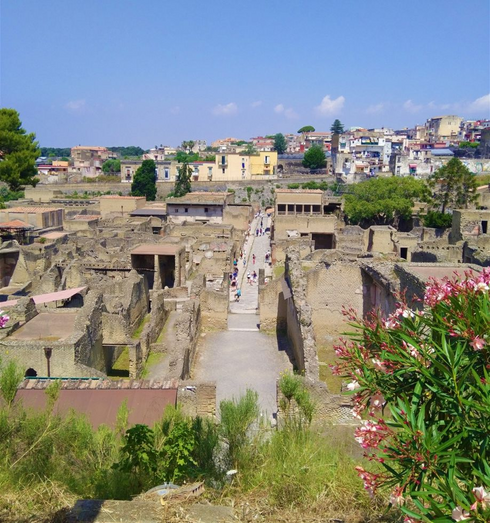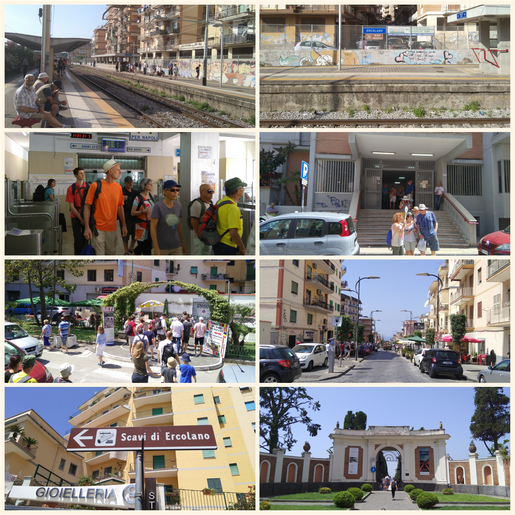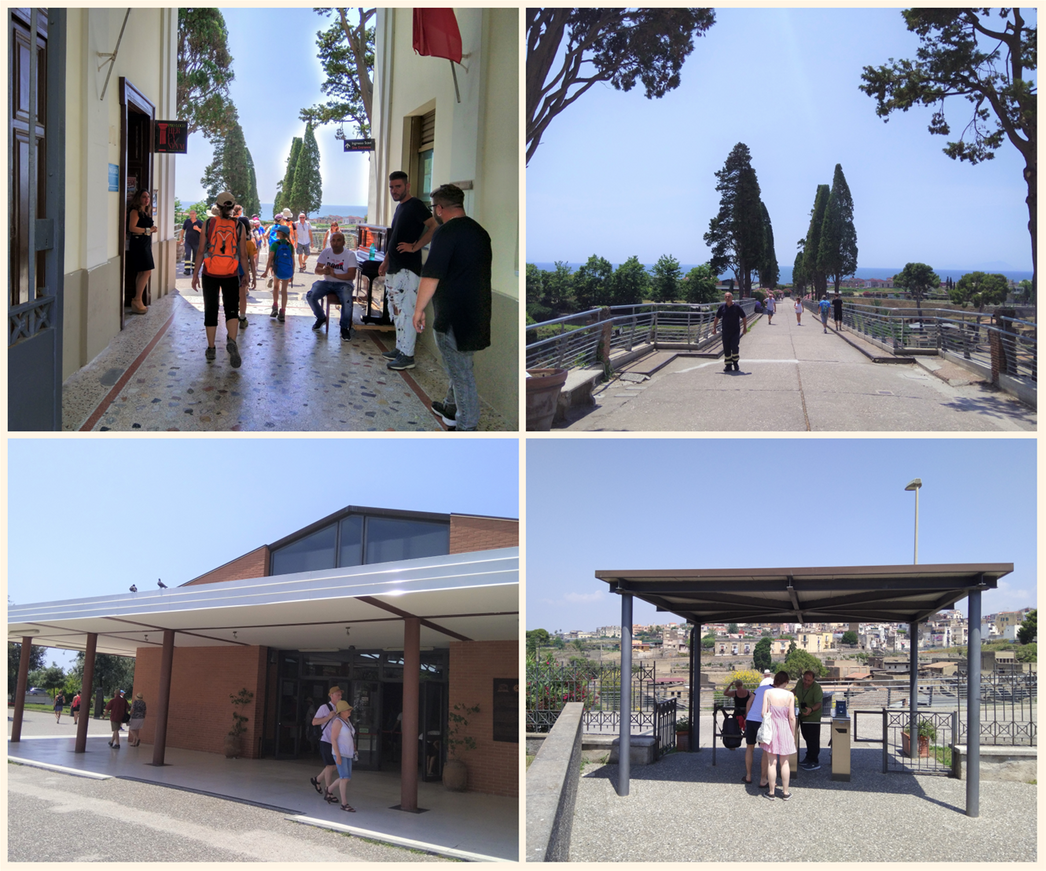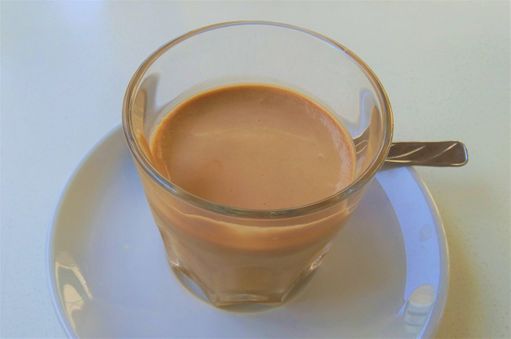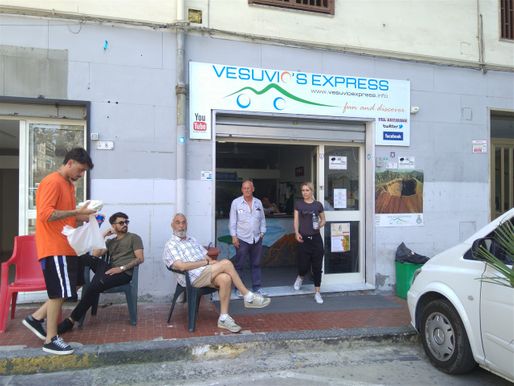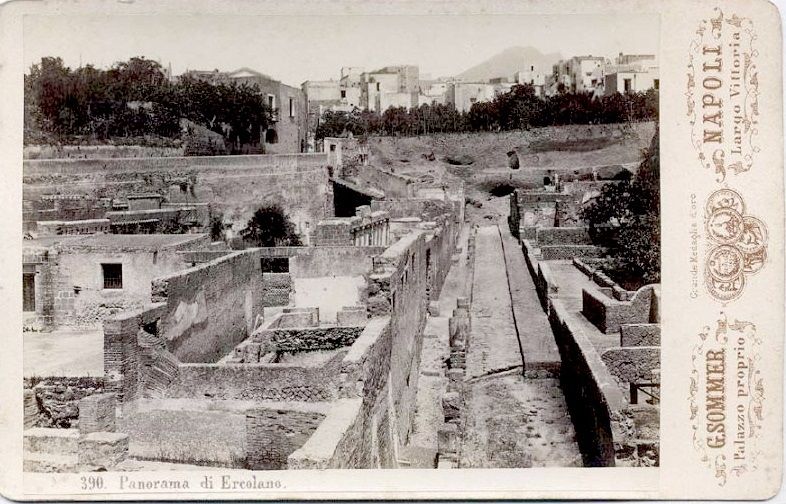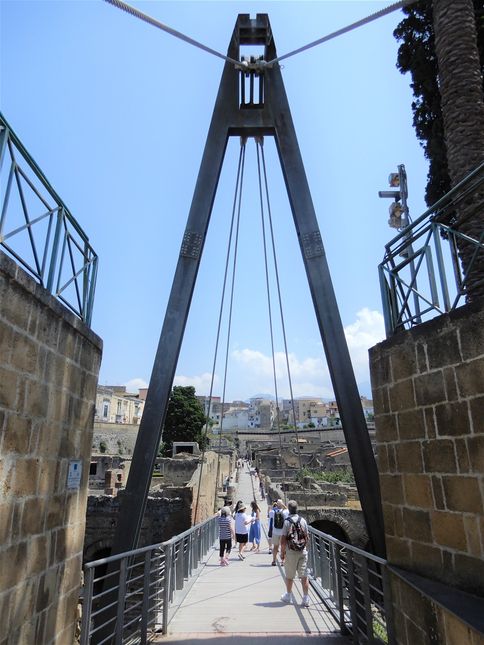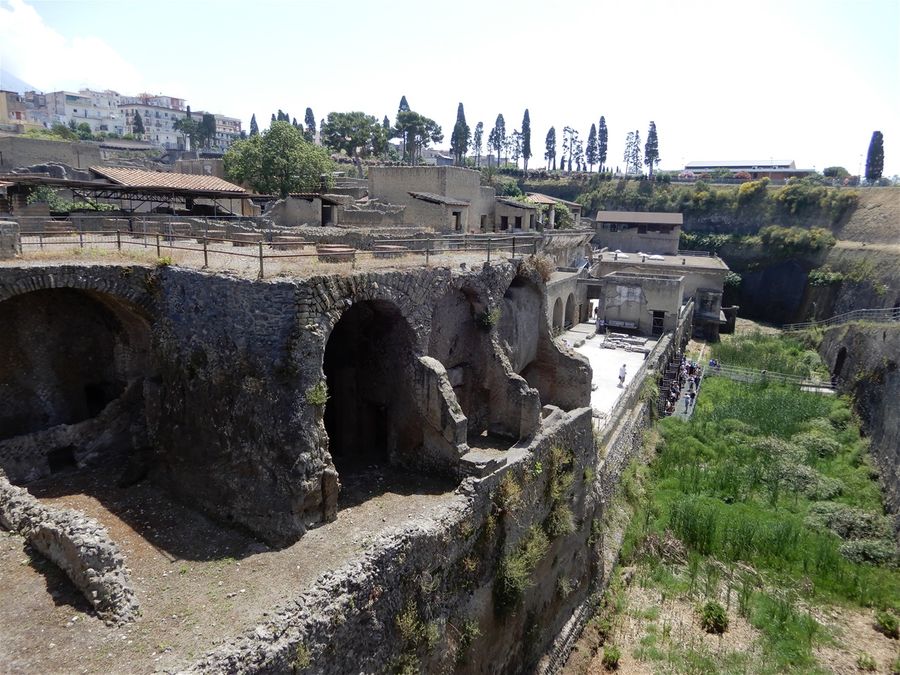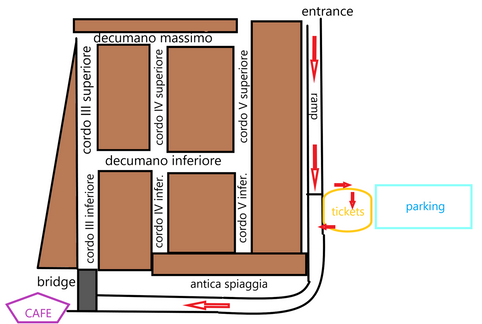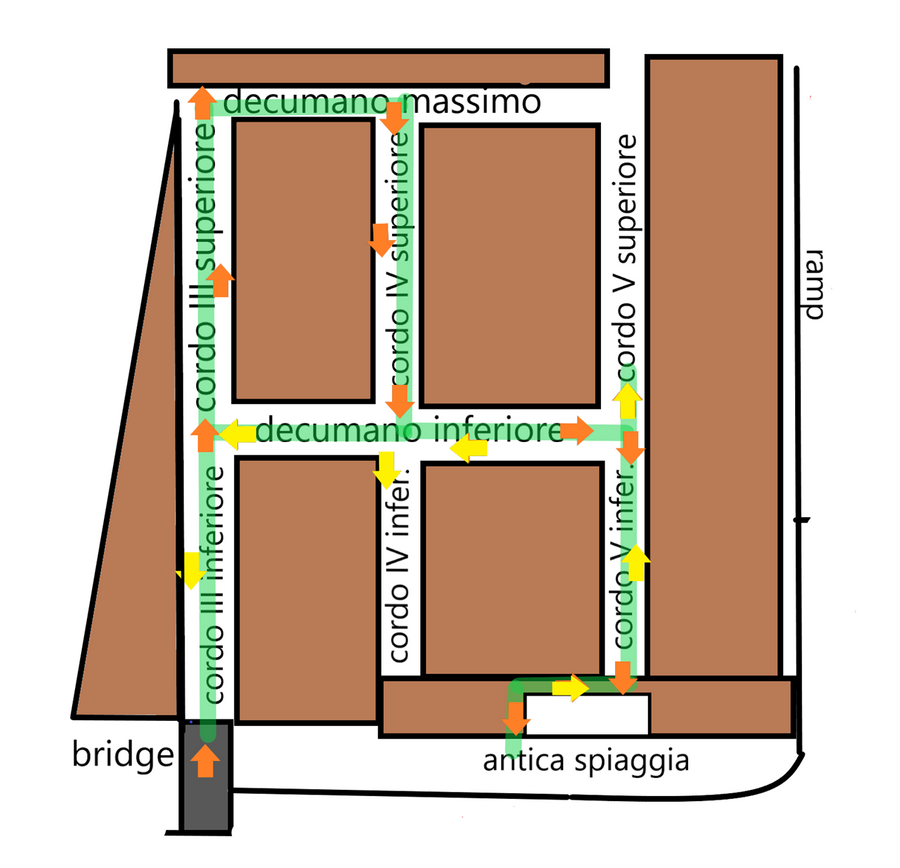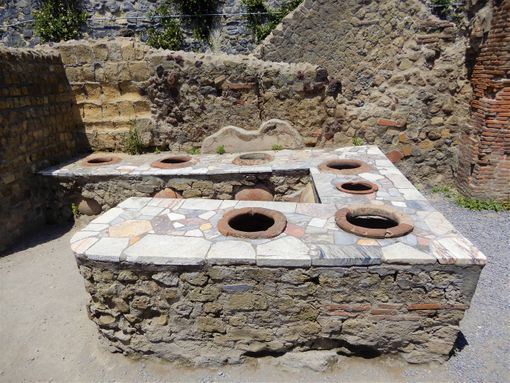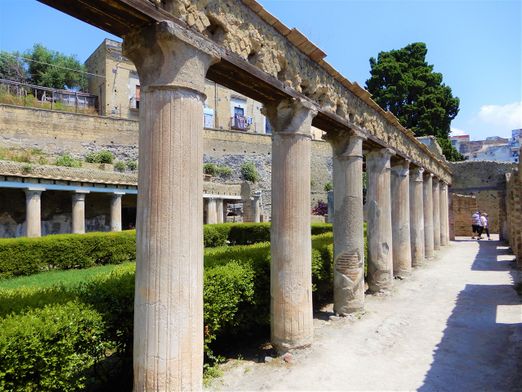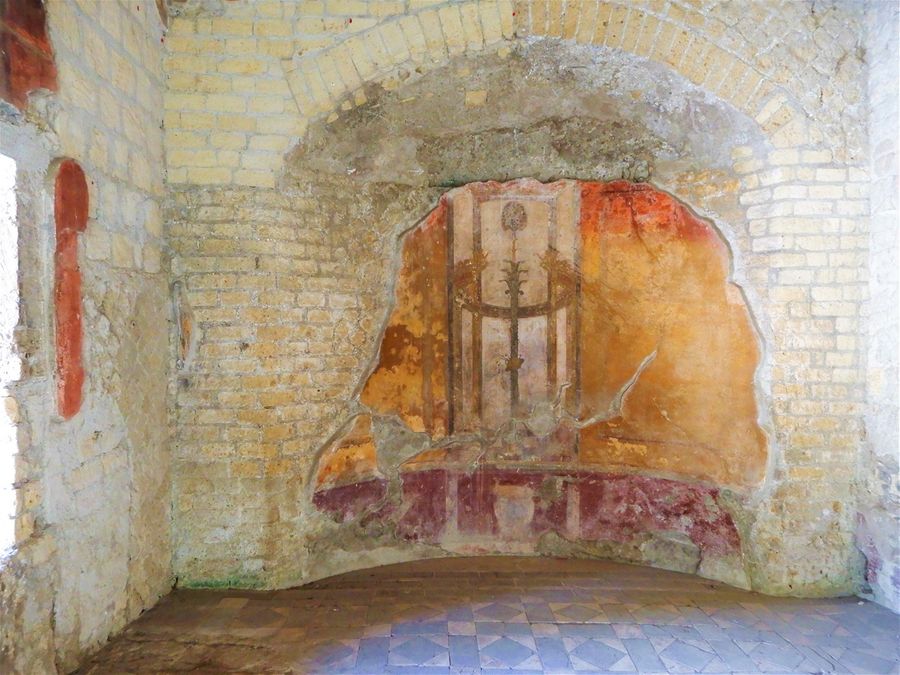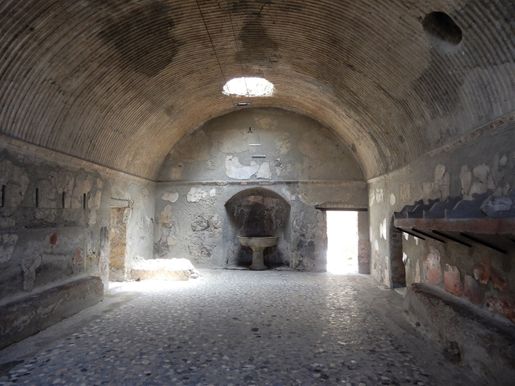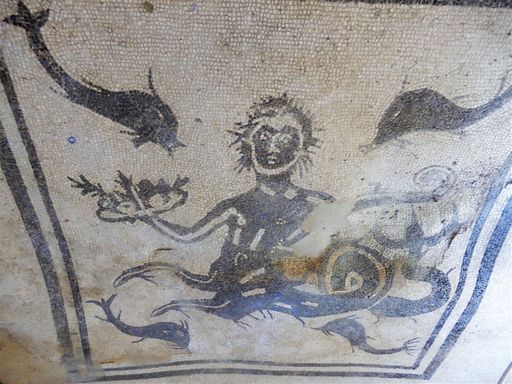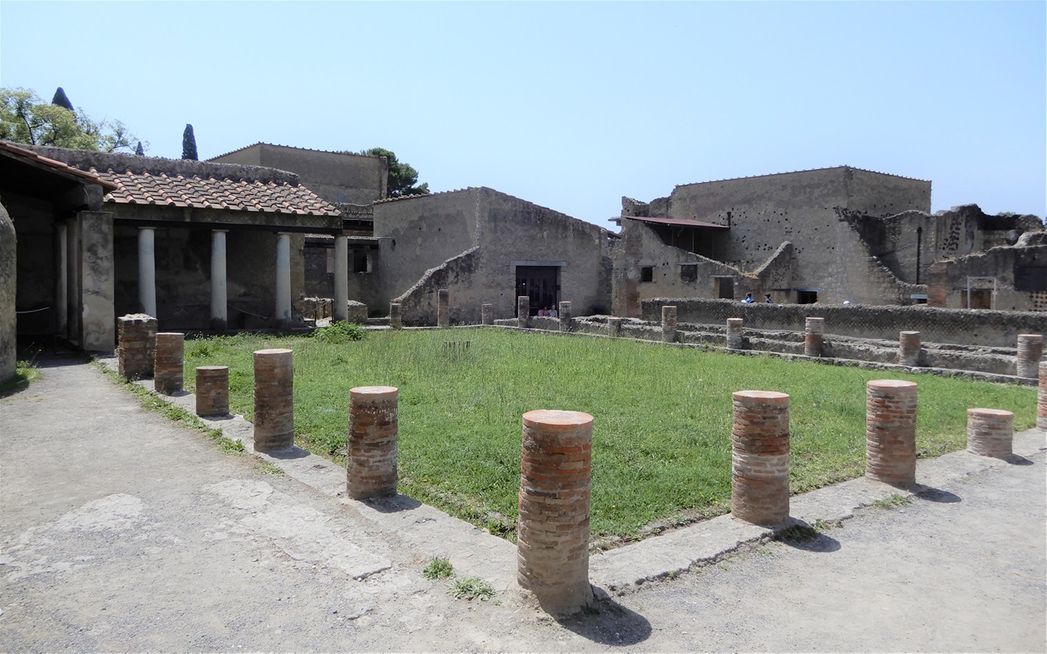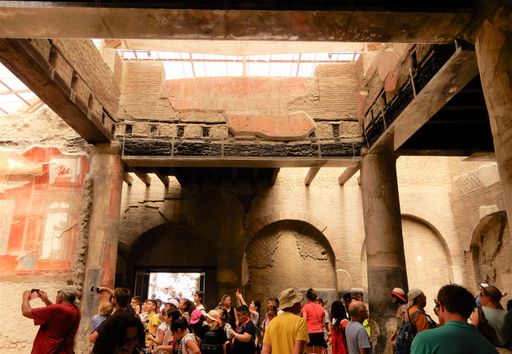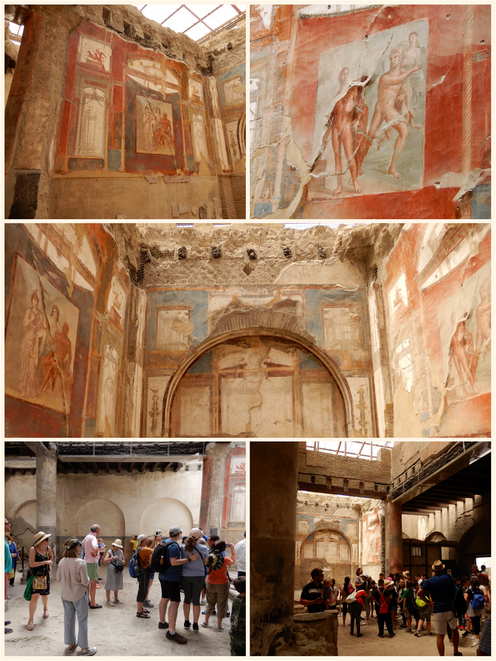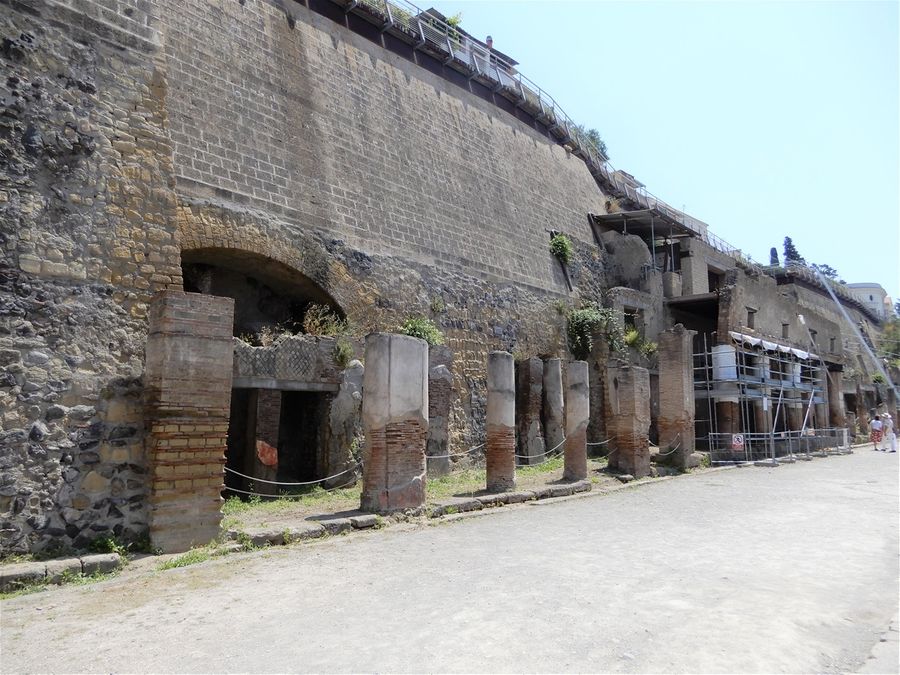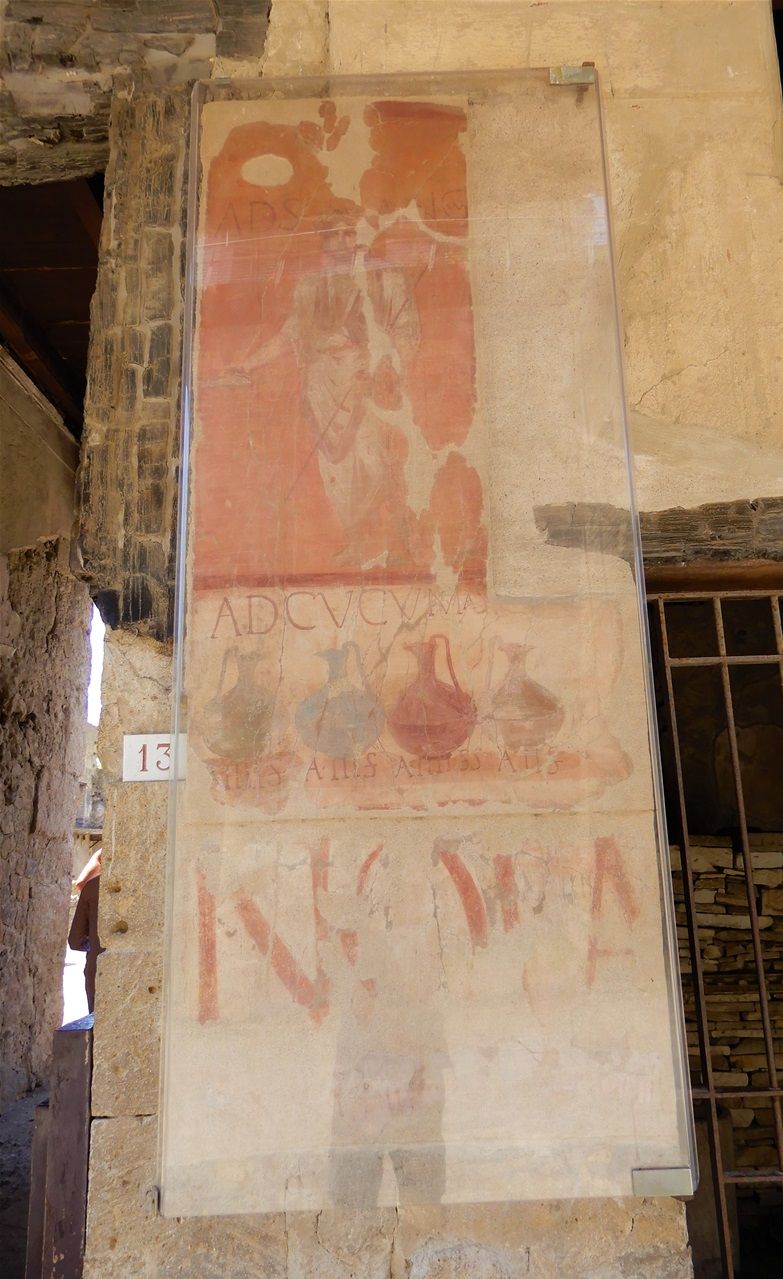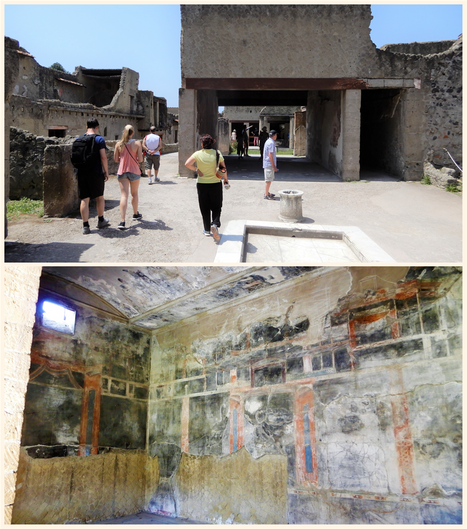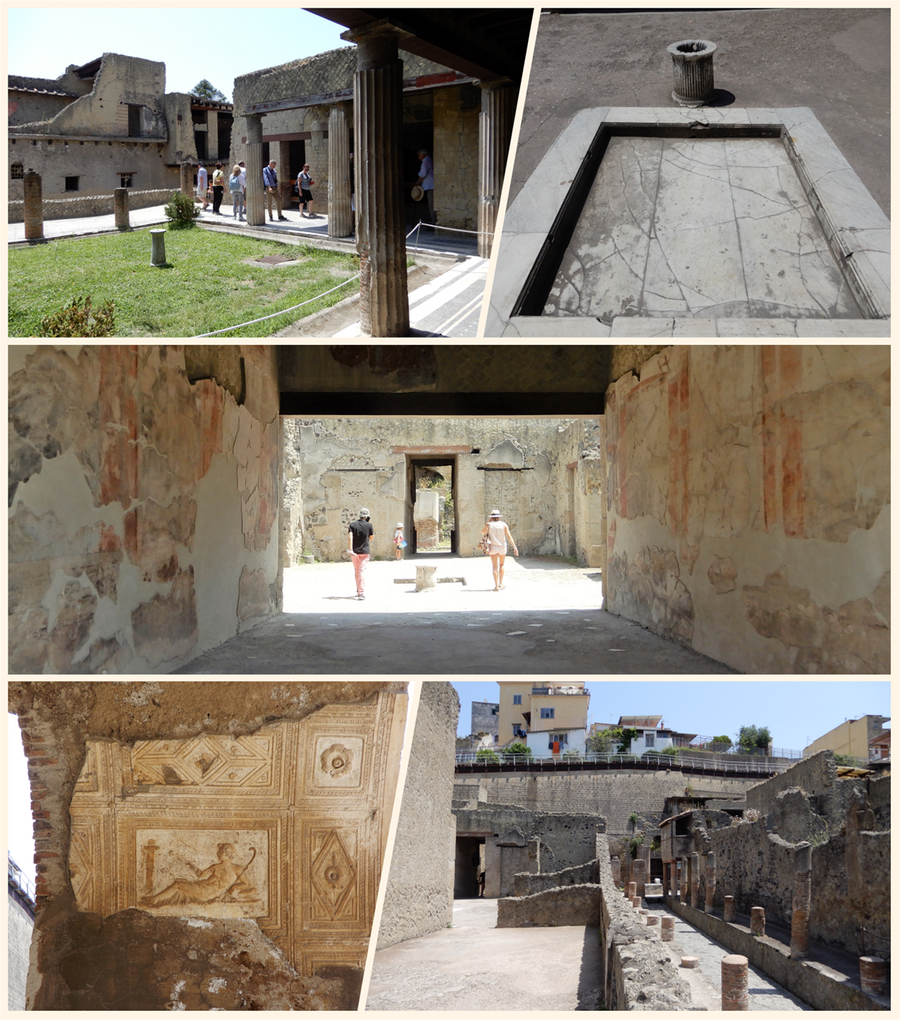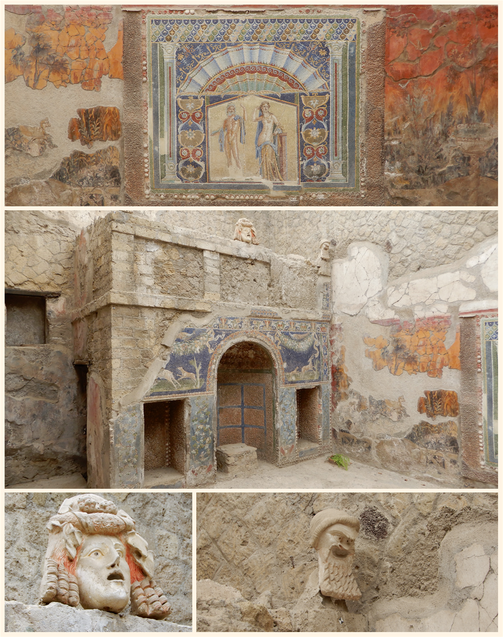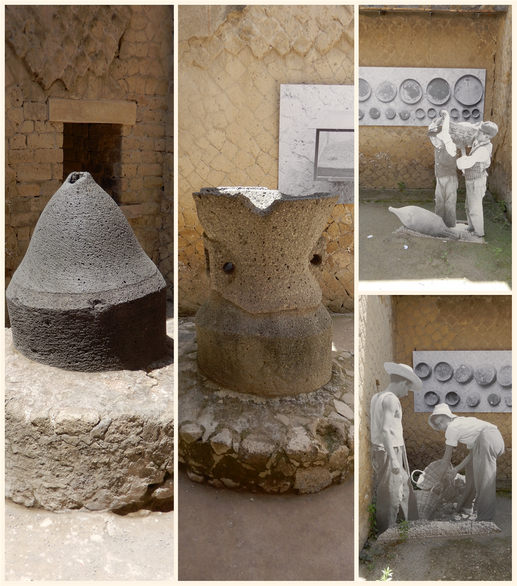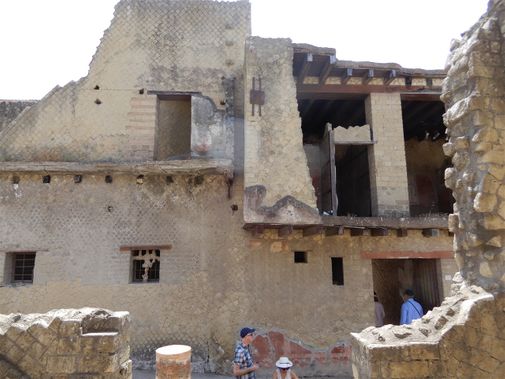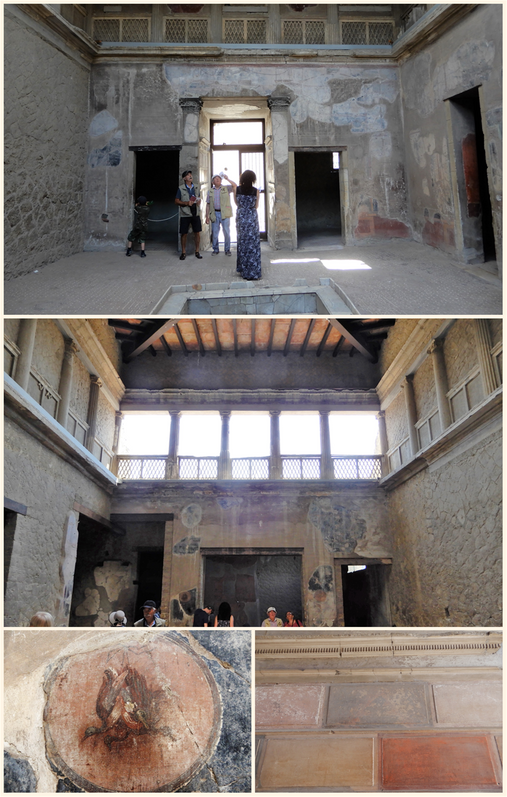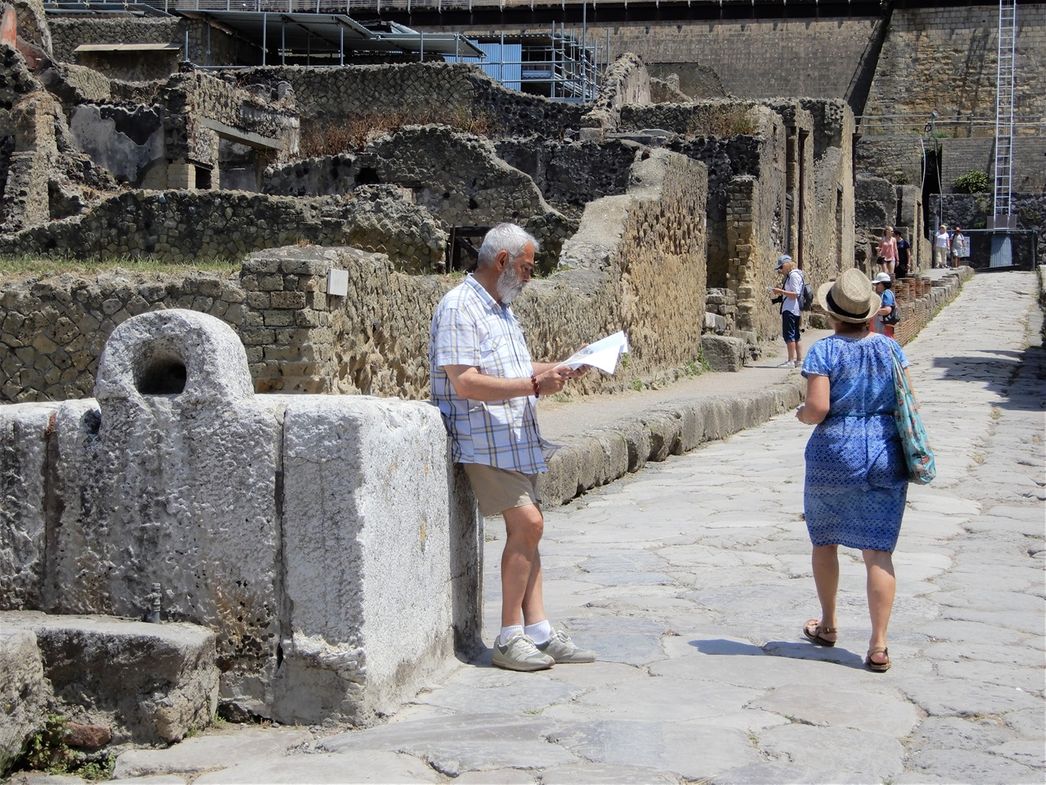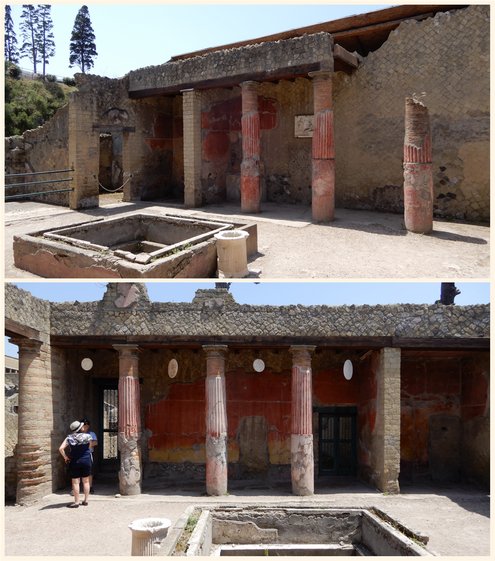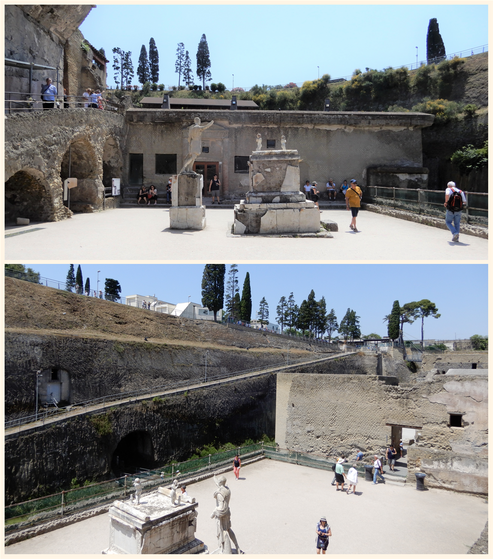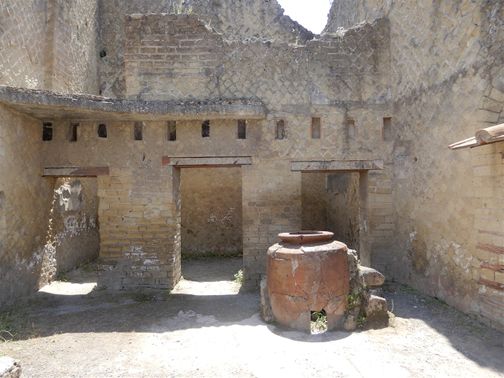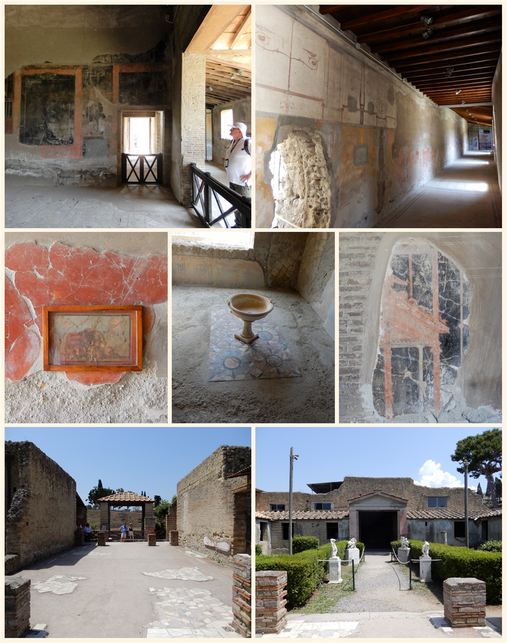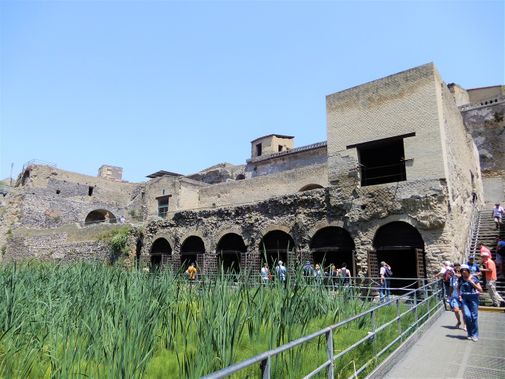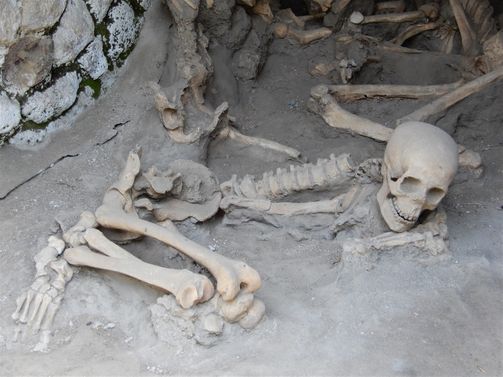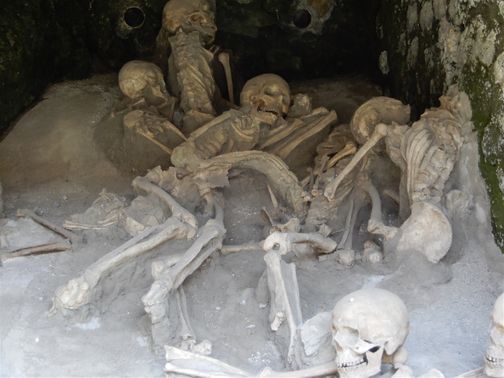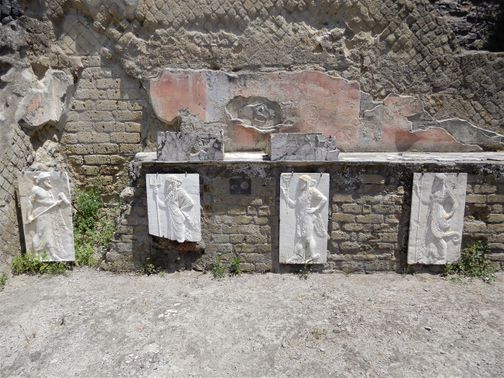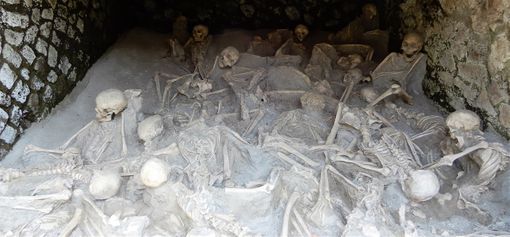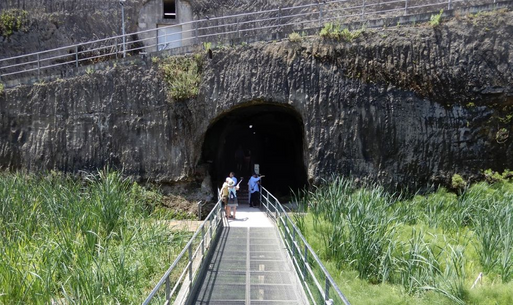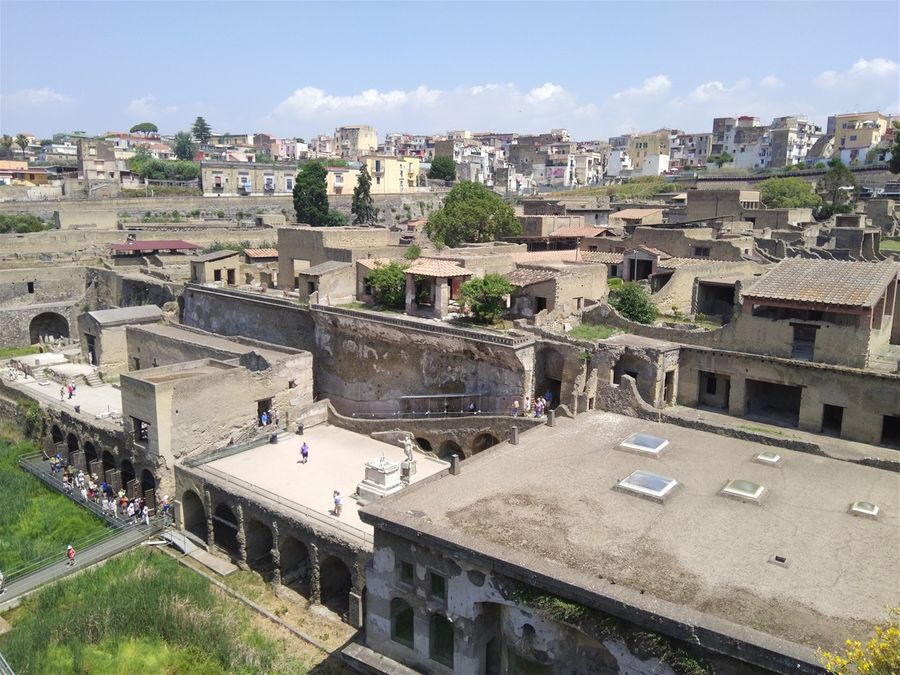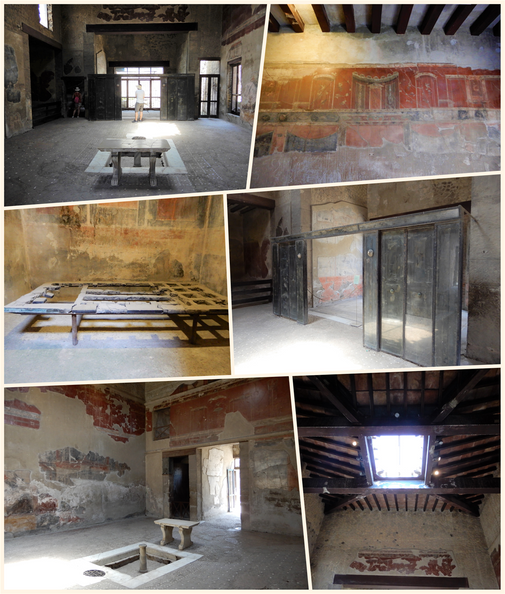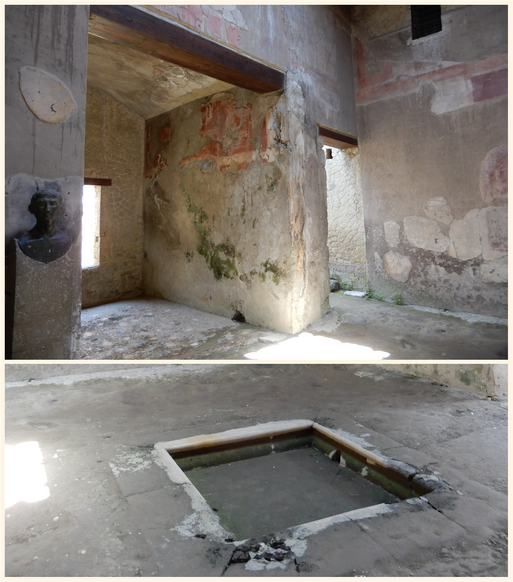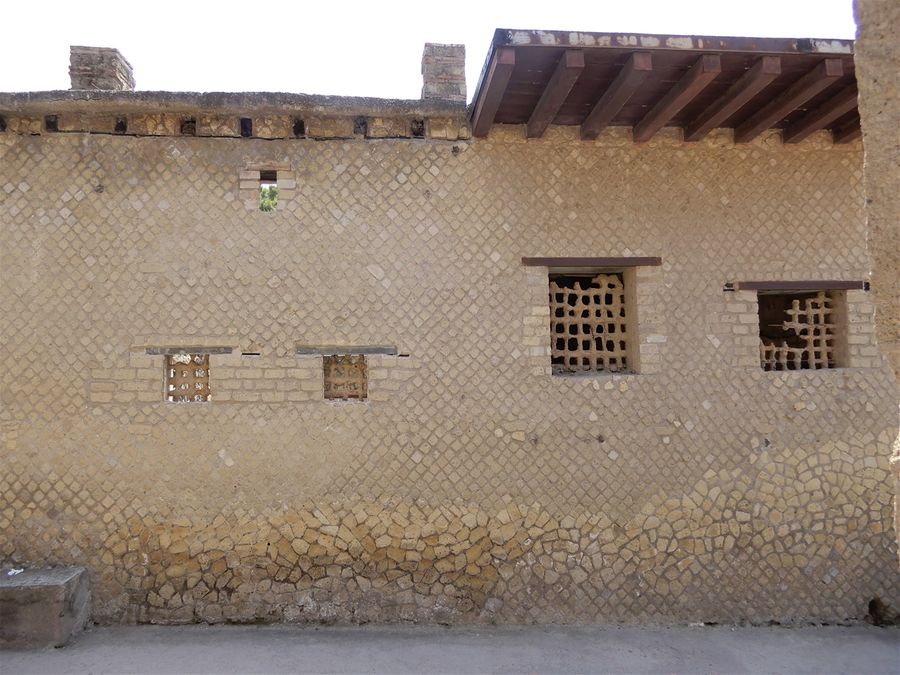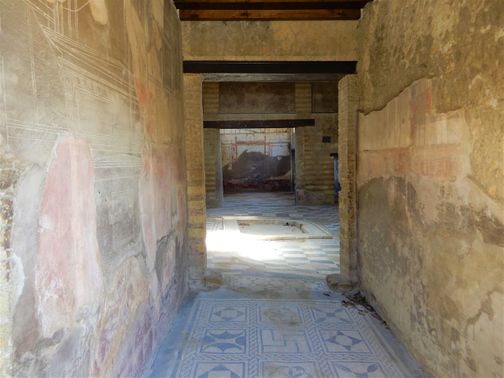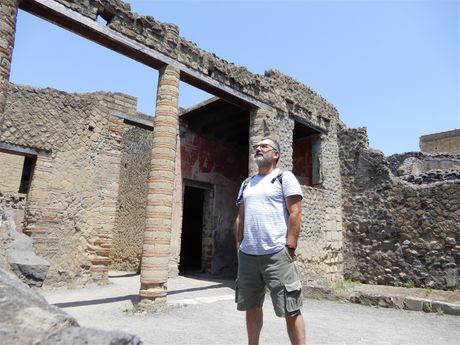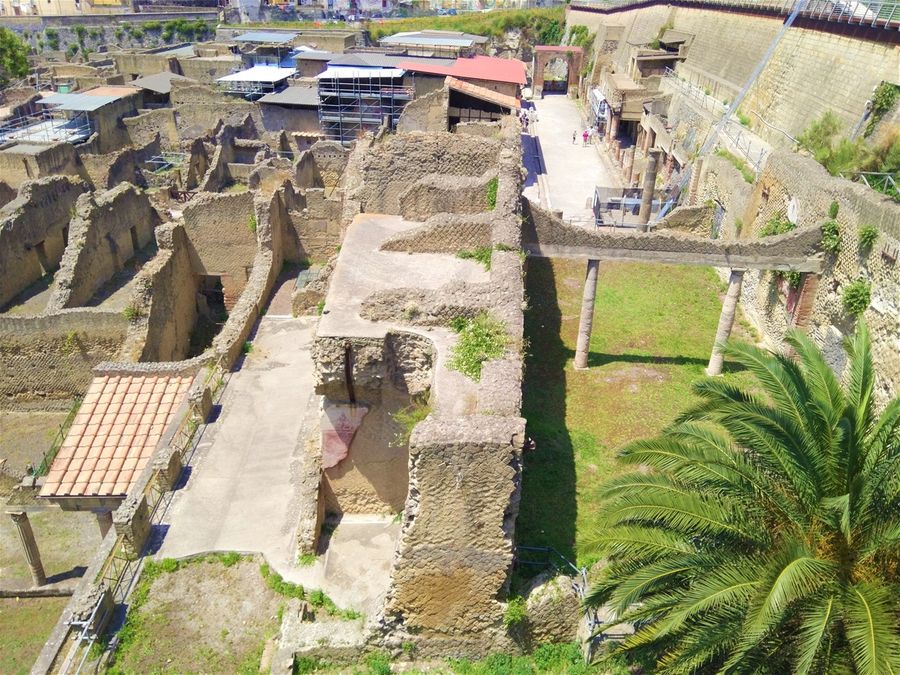June 2018
ERCOLANO
Pompeii's little sister?
Ercolano is a town that lies at the western foot of Mount Vesuvius, halfway between Napoli and Pompei. Ercolano is the name of the modern city that was built over the ancient town of Herculaneum, which destroyed from the eruption of Vesuvius in 79 AD, the same eruption that destroyed Pompeii.
Even though, Herculaneum is not as known as Pompeii and lies in the shadow of the “star” of the archeological sites, in many ways it is arguably a more interesting place to visit than Pompeii.
Surrounded by volcanic rock, its location gives you a far clearer idea of the magnitude of the volcanic eruption. The excavations form a parallelogram.
A road-ramp takes visitors gradually from the high point (almost 20m high) of the entrance to the excavations, allowing them to have a clear and more understanding view of the ancient city.
Ercolano lies between Napoli & Pompeii and can be reached by train (Ercolano Scavi station).
Note: Ercolano took its present name in 1969. Before that the town was named Resina.
Herculaneum really gives you an idea of how ancient Romans lived.
For the independent traveler there is an additional advantage over Pompeii. The excavations (scavi) are in the middle of the modern city, so congested streets around it means that access for tour buses is very difficult. Thus, there are far fewer visitors to Herculaneum than Pompei. You don't have to fight your way past hordes of other tourists in order to get into the buildings and you can explore the ruins at leisure without being overwhelmed by tour groups.
These excavations also cover a much smaller site than do those of Pompeii and thus seeing the whole site is much less exhausting and needs less time.
While roofs in Pompeii collapsed under the weight of falling ash, only a few centimeters of ash fell on Herculaneum, causing little damage. Subsequently, there was a succession of six pyroclastic flows (a mixture of ash and gases) which then solidified. These gradually buried the city's buildings from the bottom up, causing relatively little damage. The good state of preservation of the site is due to its rapid filling by these flows, which prevented the buildings from collapsing. The high temperature of the first flow carbonized wood in the buildings and extracted water from it. Restoration work is ongoing, and while a lot of the timbers have been replaced, there is still much of the original timberwork present, albeit, badly charred. Finally, the volcanic rock, or tufo, that covered the site for 1700 years formed an airtight seal.
As a consequence, there are many well-preserved buildings, many with the upper stories still intact, and some excellent frescoes and mosaics on both walls and floors to be seen.
Note: Even though, Herculaneum rediscovered earlier than Pompeii, the excavation ceased for a whole century once Pompeii was discovered, which was significantly easier to excavate because of the thinner layer of debris covering the site (4m as opposed to Herculaneum's 20m).
Note: Recent multidisciplinary research on the lethal effects of the pyroclastic surges in the Vesuvius area showed that in the vicinity of Pompeii and Herculaneum, heat was the main cause of the death of people who had previously been thought to have died by ash suffocation. This study shows that exposure to the surges, measuring at least 250 °C even at a distance of 10 kilometers from the vent, was sufficient to cause the instant death of all residents, even if they were sheltered within buildings. In the meanwhile, recent studies of fractures of skulls found in Herculaneum even suggest that the heat was so high and immediate that caused the instant evaporation of the brains of people and the subsequent skull explosion…
From train station to the Entrance of the archeological site. Ercolano Scavi station (top 2 pictures); exiting the station and its exit (second row); the little square outside the station & the downhill street Via IV Novembre (third row); there are several signs along the street leading to the arch-entrance (bottom line).
How to arrive there
The Circumvesuviana train takes 25 minutes to get there from Napoli-Porta Nolana station (2,20 euros one way) and 40 minutes from Sorrento.
To get to the ruins, get off at the Ercolano Scavi station, from where you exit into a small square. Exit diagonally right (the only way out of the square) and walk downhill (Via IV Novembre) to the big arch for a bit less than a kilometer. Walk under the arch on the ramp that gives you wonderful views over the excavations from above. The ticket office & baggage check are about a further 2 min walk after the arch.
For more info about taking the Circumvesuviana train from Napoli, etc, check my page here: visit Pompeii
From the arch to the ramp to the ticket office and to ticket check point. Enjoy!
Via IV Novembre crosses the modern town of Ercolano, so there are several cafes and restaurants along it. Take a rest on your way back to the train station, as the road is uphill. Have something to eat if you feel peckish and a drink to quench your thirst.
I had some pizza fritta and my favorite “Caffè crema”, which is something between an cold espresso and gelato. You eat it with a spoon.
Caffè crema.
Note: Besides the entrance for those coming from Ercolano Scavi train station, there is another one for those coming on a car or a tour bus. This is located at a park before the ticket office, on the west side of the excavations.
The 'Vesuvio Express' private travel office arranges to take you up to the Vesuvius summit for 10 euros (return ticket).
Note: The private tourist office ('Vesuvio Express') to your left when you come out of the station runs trips up to Vesuvius.
The best way is to arrange your day in a way to visit both Ercolano and Vesuvius summit the same day. This saves you time as you do not have to commute twice on the train. I did Ercolano in the morning and Vesuvius in the afternoon. If you do not want to visit Vesuvius or you do not have much time to spare, you can visit Pompeii in the morning and Ercolano in the afternoon, as they are both on the same Circumvesuviana line Napoli-Sorrento.
For the Vesuvius trip visit my page here: visit vesuvius
End of 19th century picture of the excavations in Ercolano. Gorgio Sommer (1834-1914).
Inside the archeological site
The entrance to the archeological site costs €11.
There is a book/gift shop at the bottom of the ramp and a non-serviced café with self-service machines, from which you can buy drinks, coffee, ice-cream and some snacks. I believe, for such an important archeological site, they could offer something more decent to cater for the visitors than just vending machines.
Leave the café and walk over a metal suspension bridge that brings you to the level of the roads of the unfortunate city. Underneath the bridge, at a big depth, there is a marshland strip. This strip is actually the seashore line those days the Vesuvius erupted (antica spiaggia). Today, the sea is further out.
Note: The excavated city is small and one can wander around, get in and out of the buildings, without really having to follow a pattern. I just give you a proposed trail you can follow: see map below.
The suspension bridge-entrance to the excavated city.
The marshland under the suspension bridge. Several boathouses are preserved.
The buildings at the site are grouped in blocks (insulae), defined by the intersection of the east-west (cardi) and north-south (decumani) streets. At the main site, there are 3 cardi (cardo III, cardo IV & cardo V) and 2 Decumani (Decumano Massimo & Decumano Inferiore). The cardi are divided into the inferior part and the superior part. Individual buildings having their own entrance number. For example, the House of the Deer is labelled (Ins IV, 3).
The way in (red arrows) and the excavated city plan.
The green path shows the walk through the site, and the arrows the direction of movement: the orange ones from the bridge to the seashore, and the yellow ones the way back.
The first buildings the visitor can visit, just after the bridge on the left hand, is the House of Aristides (the entrance opens directly onto the atrium, but the remains of the house are not particularly well preserved due to damage caused by previous excavations), followed by the House of Argos. This house got its name from a fresco of Argus guarding Io (the nymph beloved by Zeus and turned into a heifer), which once adorned a reception room off the large peristyle. The fresco is now lost, but its name lives on.
This building must have been one of the finer villas in Herculaneum. The discovery of the house in the late 1820s was notable because it was the first time a second floor had been unearthed in such detail.
Thermopolium.
The large three-armed peristyle of the House of Argos.
Further on you can see the thermopolium, a public dining establishment that served hot food and drinks (whence the Greek name): it was customary to lunch outside the home. The typical structure was simple: one room opening onto the road, with a brick counter decorated with marble or terra-cotta slabs, into which were sunk the jars containing the goods: at times, one could sit down in the back rooms to eat one's meal. Many amphorae were found in the back room of this thermopolium, one of which bore an inscription painted by a Herculaneum craftsman: M. Livi Alcimi Herclani.
Fresco at the House of the Skeleton. The house is located opposite the thermopolium.
The northeast block (Cordo III sup. - Decumano Mas. - Cordo IV sup. - Decumano inf.) has some of the most interesting buildings. Among them the Central Baths and the Hall of the Augustals.
The Central Baths have the typical division into men's and women's sectors. This bath facility, originally fed by a large well, was built during the second half of the 1st century BC. The entrance to the men's section is in Cardo III. A corridor leads to the apodyterium (changing room), with niches for storing one's garments; west of here is the circular frigidarium (cold bathing room), with red walls and four niches painted yellow beneath the blue dome; to the east we instead find the tepidarium (warm room), with a black-and-white mosaic depicting a Triton (sea God) among dolphins, an octopus, squid and a cherub with a whip, and the apsidal caldarium (hot room).
Men's Baths: black-and-white mosaic depicting a Triton (sea god) among dolphins, an octopus, squid and a cherub with a whip.
The entrance to the women's section of the Central Baths is from Cardo IV. Passing a waiting room with masonry seats along the walls, one enters the apodyterium (changing room) with a barrel vault. This is followed by the tepidarium (warm room), with shelves for storing garments and its meandering mosaic floor, and the caldarium (hot room), with vaulted ceiling and two sumptuous seats, one of white marble, the other dark red.
Women's baths.
Behind these rooms are the heating furnace and the (8.25 m deep) well. To the south the bath complex is connected to the palaestra, an outdoor courtyard surrounded by porticos, with brick Ionic columns covered with stuccoes.
To the south the Central Bath complex is connected to the palaestra, an outdoor courtyard surrounded by porticos, with brick Ionic columns covered with stuccoes.
At the corner of Cardo III and Decumano Massimo stands the Hall of the Augustals. For the freed slaves (liberta), becoming Augustals meant entering into the dynamics of upward mobility. Their ‘board’, dedicated to worshiping the emperor Augustus, held its meetings in the area of the Forum, where all political, religious and commercial life took place. This is a building with a quadrangular layout, with walls separated by blind arches and four central columns: the floor is made with powdered terracotta, mixed with lime and sand (signinum opus); that of the upper floor was made of bricks arranged in a herringbone pattern (opus spicatum).
Hall of the Augustals.
Later, a cell was built aligned with the entrance, which partly retains its original floor and wainscoting covered with marble, and frescoes: on the left wall is depicted the entrance of Hercules in the Olympus, accompanied by Jupiter, in the form of a rainbow, Juno and Minerva; the one on the right alludes instead to the battle between Hercules and the Etruscan god Achelous. In the back, to the right of the sacellum, is the caretaker's room in opus craticium (economical building technique with square wooden frames filled with crushed rocks, bound together with lime and mud), whose skeleton was found lying on the bed. An inscription now placed on the wall reminds us that the building, dedicated to Augustus while still living, was built by the brothers A. Lucius Proculus and A. Lucius Iulianus, who offered a luncheon to the members of the municipal senate and the Augustals on its inauguration day.
Hall of the Augustals.
On the Decumano Massimo side of the same block one can see the Sacellum, a Thermopolium, the Plumbarious Shop and the Cucumas shop, through which we ender into the House of the Black Room.
Decumano Massimo.
Cucumas's shop (Bottega ad Cucumas). Cucumas's shop, or inn, bears a wall painting by its entrance which announces the prices of pitchers of wine, along with illustrations. At the top can be seen the figure of Semo Sanctus, a divinity often compared to Hercules and who was said to protect business, with the inscription “ad Sancum”. The panel at the bottom with the inscription NOLA in red letters is the announcement of a show.
At the corner of Decumano mas. & Cardo IV stands the House of the Black Room. An archive of 20 wax tablets, found in a room, informs us about the rich libertus L. Venidius Ennychus, who either lived in the house or managed it on behalf of the owner.
The entrance still has its frame, architrave and part of the door of carbonized wood. The house follows the sequence vestibule, atrium, tablinum, peristyle: the latter has a black mosaic floor and columns arranged so that the garden could be seen from the rooms.
The ‘black room’, on the western side of the peristyle, and the two living rooms, are painted in a sophisticated way. In the ‘black room’, with its white mosaic floor, excavators found a marble table and a prized wooden lararium with marble capitals.
The House of the Black Room. The atrium (top) and the black room (bottom).
The House of the Black Room.
Opposite the House of the Black Room on the Cardo IV Superiore (there is an exit here, too) stands the House of the Beautiful Courtyard next to a shop (botega).
Walk further down the Cardo IV Superiore street and enter into the House of Neptune and Amphitrite with the glass paste wall mosaic depicting Neptune and Amphitrite; and then into the beautifully restored Samnite House with the splendid Hellenistic-style atrium, before turning left on Decumano Inferiore.
The House of Neptune & Amphitrite. The glass paste wall mosaic depicting Neptune and Amphitrite, adorns the east wall of the triclinium, while the north side is occupied by a nymphaeum, also covered with a glass paste mosaic and topped with marble theatrical masks.
This Samnite House, built in the 2nd century BC, originally occupied all of the south side of the block. Its currently visible appearance is the result of changes made over time. The residence at first ceded its garden space to the adjacent House with Large Portal, then, after the earthquake in 62 AD, the rooms on the upper floor were separated from the house and rented out, creating an independent entrance.
The splendid Hellenistic-style atrium, with walls painted all over, is crowned at the top by an arcade closed on three sides by false columns and transenna. The floor is made of powdered terracotta (mixed with lime and stone) and is dotted with white tiles, while that of the tablinum (the public room between the atrium and the peristyle) is adorned with a rosette of diamond shapes centered around a round copper tile. During the final remodeling, the low basin in the center of the atrium (into which rainwater flown down from the roof) was covered with marble.
To the right of the entrance there is a room with a green monochrome fresco, decorated with architectural motifs, hangings and, in the centre, a small panel illustrating the Rape of Europa. The room has a red and white mosaic floor and is lit by a small window in its south wall.
The pistrinum of sex. Patulcus Felix on Cardo V superiore.
The House of the Beautiful Courtyard on Cardo IV superiore.
The House of Neptune and Amphitrite draws one's attention due to the rich decoration of the summer triclinium (*), glimpsed even through the window of the tablinum aligned with the entrance.
The conventional name of the residence derives from the glass paste wall mosaic depicting Neptune and Amphitrite, which adorns the east wall of the room, while the north side is occupied by a nymphaeum, also covered with a glass paste mosaic, with shells and lava foam and topped with marble theatrical masks.
Above the niche area is the tank that fed the fountain. In the lararium of the atrium were discovered two shattered marble slabs painted with red lines, one of which bearing the artist's signature in Greek.
(*) The triclinium was a formal dining room in a Roman house and it was characterized by three couches (chaise longue) on three sides of a low square table, whose surfaces sloped away from the table at about 10 degrees. Diners would recline on pillows on these surfaces in a semi-recumbent position. The fourth side of the table was left free, to allow service to the table. Usually the open side faced the entrance of the room.
The Samnite House.
There are many shops along the northern section of Cardo V (the widest of the 3 uncovered streets), which are long and narrow, and their mezzanines were used as living quarters. Among these are the city's only two known pistrina (bakeries), both equipped with two millstones. The many manual millstones found in the digs inform us that, in Herculaneum, most people ground their own flour at home.
The baker Sex. Patulcius Felix seems to be the owner of the pistrinum located just east of the Palaestra, as evidenced by a signet ring found here. The oven (built behind the apsidal room of the Palaestra) was protected from the evil eye by two stucco phalluses at the entrance: the same ones appear on a slab in the laboratory. The 25 round bronze baking pans, found in the back room of the shop, were used for baking the flat loaves (placentae).
By the fountain at the intersection of Cardo V and Decumano Inferiore.
Other excavated shops that may be visited are the three taverns at the intersection of Cardo V and Decumano Inferiore: Taberna of Priapus (which stands out among the numerous shops for two reasons: the half-buried jar, in which some walnuts were found, and the small pantry covered with signinum opus, located in front of the counter), the Large Taverna (with the marble-covered counter in which jars are inserted) and the Taberna Vasaria opening onto Decumanus Inferior.
A shop in Cardo V Inferiore.
The House of Relief of Telephus.
The last house on the Cardo V, before going down the stairs to the Terrace of M. Nonius Balbus, is the House of the Deer. Finding a loaf of bread with the stamp of Celer, slave of Q. Granius Verus freed shortly before the eruption in 79 AD, has made it possible to identify the owner of the house. The atrium is small, but with a gallery and servants' rooms on the upper floor: to the right a corridor leads to the dining room, the kitchen and an alcove; to the left is a large complex of public rooms. The windowed cryptoporticus encloses the large garden where round marble tables were found as well as statues: a deer attacked by dogs, a Satyr with a wineskin and a drunken Hercules. Aligned with the garden and emphasized by the tympanum, with a blue glass paste mosaic depicting Cherubs riding sea animals and the head of Oceanus, is a large sitting room followed by the scenic terrace overlooking the sea, preceded by rooms with floor of prized marble tiles.
Terrace of M.Nonius Balbus. The Suburban Baths (top) and the entrance to the Sacred Area (bottom).
Further down Cardo V inferiore visit the House of Relief of Telephus. With the adjacent House of the Gem, this house formed a complex that may have belonged to M. Nonius Balbus and is the second largest in Herculaneum. Built in a scenic position, on the slop leading down to the marina, the house was built on three levels and held a rich collection of sculptures of the neo-Attic school, including the relief with the myth of Telephus, son of Hercules (mythical founder of the city). The structure current dates from the Augustan period (27 BC-14 AD), and was remodeled after the earthquake in 62 AD. The atrium is similar to a peristyle, with columns supporting not the slopes of the roof, but the rooms of the upper floor, as in certain Greek houses. Between the columns hang the plaster casts of the marble oscilla found here (discs or masks, generally in a Dionysian theme, used to ward off evil).
The House of Deer.
Climbing down the ramp against the walls brings you into a large rectangular piazza, in front of the complex of the Suburban Baths. Here stands the funeral altar, covered with marble, which by decree of the local senate was dedicated to the senator M. Nonius Balbus, praetor and proconsul of the provinces of Crete and Cyrene, tribune of the plebes in 32 BC and partisan of Octavian, the future ‘Augustus’. M. Nonius Balbus did good service towards the city of Herculaneum by restoring and building many public buildings: at least 10 statues were erected in his honor, and great honors bestowed upon his death, recalled in the long inscription engraved on the side of the funeral altar facing the sea. On the marble base next to the funeral altar was the armored statue of M. Nonius Balbus himself, also made of marble.
From the piazza (Terrace of M.Nonius Balbus) one can have a good view of the deep excavation walls and the swamp where the seashore used to be. On the southern part of the piazza you can visit the Suburban Baths, while through the entrance on the northern side you can visit the Sacred Area with the Sacellum of Venus and the Sacellum of the four Gods (Terrazza meridionale). Just before the entrance to the Sacred Area, steps take the visitor down to the Barrel Arches, the vaulted rooms used as port warehouses or boathouses.
Restored after the earthquake in 62 A.D., the Sacellum of Four Gods is dedicated to four divinities, as evidenced by the lovely archaistic reliefs, perhaps from the Augustan period, recently found and originally fastened to the front side of the podium standing at the back of the cell. These depict Minerva, Neptune, Mercury and Volcano, all divinities related to the world of manufacture, trade and crafts. The floor of the pronaos (vestibule) and the Corinthian columns are made of cipolline marble. Part of the wooden structure of the roof was recently recovered, dragged onto the beach below by the force of the eruption.
The boathouses under the Sacred Area, where the sceletons were found. The stairs to the right lead to the Terrace of Nonius Balbus.
The study of victims' postures and the effects on their skeletons indicate that the first surge caused instant death as a result of fulminant shock due to a temperature of about 500 °C. The intense heat caused contraction of hands and feet and possibly fracture of bones and teeth.
In Roman times, the coast of Herculaneum must have been much closer.
Indeed, one effect of the earthquake in 79 AD was to sink the beach by approximately 4 m, and the material erupting from Vesuvius added a strip of land to the sea, approximately 400 m wide.
Sacellum (Temple) of the four Gods.
Going down the stairs to the boathouses the visitor has a macabre and sad experience. In 1981, excavations initially turned up more than 55 skeletons (30 adult males, 13 adult females and 12 children) on the beach and in the first six boat chambers. Because earlier excavations had revealed only a few skeletons, it was long thought that nearly all of the inhabitants had managed to escape, but this surprising discovery led to a change of view. The last inhabitants waiting for rescue from the sea were killed instantly by the intense heat, despite being sheltered from direct impact.
Further excavations in the 1990s revealed a total of at least three hundred skeletons huddled close together in twelve arches facing the sea and on the beach, while the town was almost completely evacuated. The famous "Ring Lady", named for the rings on her fingers, was discovered in 1982.
In the same area (summer 1982) were found a well-preserved Roman boat, 9 m long, and the skeletons of the so-called rower and of a soldier, with belt, two swords, scalpels and a bag of coins.
From the boathouses a metal bridge takes you to a subterranean path (exit) out to the cafe area.
Chemical analysis of the remains has led to greater insight into the health and nutrition of the Herculaneum population. Pioneering work in the chemical and physical analysis of skeletons yielded new insights into the nutrition and health of ancient populations. This was considered ground-breaking and helped advance the field of paleodemography. Quantities of lead were found in some of the skeletons, which led some to speculation of lead poisoning.
Also the presence of scarring on the pelvis, for instance, may give some indication of the number of children a woman had borne.
Casts of skeletons were also produced, to replace the original bones after taphonomic study, scientific documentation and excavation. In contrast to Pompeii, where casts resembling the body features of the victims were produced by filling the body imprints in the ash deposit with plaster, the shape of corpses at Herculaneum could not be preserved, due to the rapid vaporization and replacement of the flesh of the victims by the hot ash.
The Terrace of M.Nonius Balbus. The Sacred Area to its left and the Suburban Baths on its right. Above of it is the House of the Deer and bellow it the boathouses with the sceletons. At the background one can see the houses of the modern city of Ercolano.
From the boathouses and the skeletons, a metal bridge takes the visitor to a subterranean path (exit), that leads outside the excavations area and to the café above. So, one can finish the exploration of the city here.
But, if you still have time to explore a couple of more places, take the same road back to Cardo V inferiore and then to Decomano Inferiore. Admire the portal of the House with large Portal, just opposite Taverna Vasaria. This lovely half-columned portal, with brick lintel and cornice, built after the earthquake in 62 AD, but reuses the Hellenistic tufa capitals symbolizing Victory.
The House of the Wooden Partition.
The lower part of Cardo Inferiore has some excellent samples of Herculaneum houses: the House of the Alcove, the House of the Bronze Herm, the House of the Mosaic Atrium, the Trellis House and the Inn House. If you have time, they worth a short visit.
The House of the Bronze Herm is a small dwelling centered around a Tuscanicum style atrium (roof supported by beams), with signinum opus floor, a central tufa tub and decorated walls with paintings. This room displays the casting of the bronze herm (portrait on pilaster) of the homeowner. Of great interest are the tablinum, for its floor, and the triclinium behind, which retains excellent renovated paintings, among which the most outstanding is a seascape painting.
Decumano inferiore seen from its intersection with Cardo V. On the right one can see the red brick portal of the House with large Portal. The door just opposite the portal Leads to the Taberna Vasaria.
At the corner of Decumano Inferiore and Cardo IV stands the impressive and very well-preserved House of the Wooden Partition. The entrance to this dwelling is flanked by two masonry seats, a waiting room for clients. The name derives from the wooden partition, a sort of folding gate that shields the atrium towards the tablinum, to maintain privacy. The partition has profiled panels with rings and supports for hanging oil-lamps. The floor of the large atrium is decorated with white tiles, dating from the most ancient stage of the residence. The marble covering of the impluvium tub, the wall paintings and the geometric mosaic of the room to the right of the entrance date from a restoration from approximately the mid-1st century AD. Behind the tablinum is the area of the peristyle, which extends almost to Cardo III Inferiore.
House of the Bronze Herm.
The exterior of the House of the Alcove, on Cardo IV inferiore.
The House of the Mosaic Atrium.
The House of the Mosaic Atrium is an aristocratic residence built in a scenic position, elegant in both its painted decorations and architectural space. The name derives from the geometric black-and-white mosaic, with a checkerboard motif in the atrium, while the vestibule is inspired by the coffered ceilings. The ancient tablinum, aligned with the entrance, was converted into a hall with three naves, similar to a basilica, a room of extraordinary architectural significance that represents the only known example discovered so far throughout the Vesuvian area. The garden, with its marble-covered fountain, is surrounded on three sides by porticos, and a windowed veranda on the north side.
Take your way back to Decumano Inferiore and turn to Cardo III Inferiore. This is the end of your walk-through history trail. This city is certainly emotionally overwhelming.
On one hand, visiting it is a tremendous experience, as one very rarely has the opportunity to walk in ancient streets and into almost intact houses build more than 2000 years ago: it is one of those unique experiences of actually “living” in a city of the very past. On the other hand, it is so sad to see those desperate people crouched in the boathouses and the beach expecting to be saved from the inferno…but, alas never making it!
I just realized that this is the only picture I took of me in Ercolano.... I do not even remember where that was taken... oh, well.
Well, this is one of my best trips ever, and I certainly recommend it to everyone visiting Napoli.
One last snapshot of this amazing archeological site...before exiting.

